Skip to main content
High-Fiber Super Foods
Start Your Day With Whole Grains
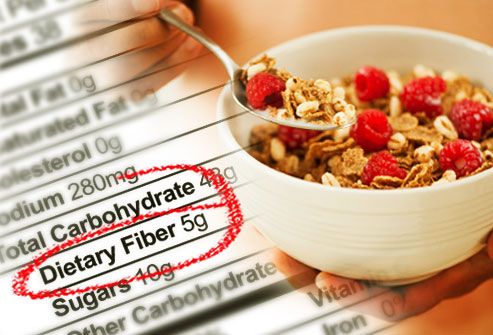
Americans don't eat enough fiber. On average, we get less than half of
what we need of this nutrient that can lower cholesterol, prevent
constipation, and improve digestion. Most whole grains are a great
source of fiber. Start at breakfast: Look for whole-grain cereal or
oatmeal with 3 or more grams of fiber per serving. Add fruit and you'll
be on your way to the daily goal of 38 grams for men and 25 grams for
women.
Fiber and Fresh Fruit
 Any type of fresh fruit is a healthy snack. But when it comes to fiber,
all fruits are not created equal. One large Asian pear has a whopping
9.9 grams of fiber. Other high-fiber fruits include raspberries (4 grams
per 1/2 cup), blackberries (3.8 grams per 1/2 cup), bananas (2.4 grams
each), and blueberries (2 grams per 1/2 cup). Pears and apples -- with
the skin on -- are also high-fiber choices.
Any type of fresh fruit is a healthy snack. But when it comes to fiber,
all fruits are not created equal. One large Asian pear has a whopping
9.9 grams of fiber. Other high-fiber fruits include raspberries (4 grams
per 1/2 cup), blackberries (3.8 grams per 1/2 cup), bananas (2.4 grams
each), and blueberries (2 grams per 1/2 cup). Pears and apples -- with
the skin on -- are also high-fiber choices.
Try Whole-Grain Bread and Crackers
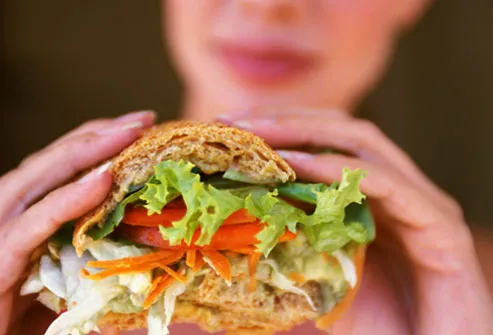 Keep the grains coming at lunch. Eat a sandwich on whole-grain bread. Or
dip whole-grain crackers into your favorite healthy spread. Whole
grains include the entire grain -- bran, germ, and endogerm -- giving
you all the nutrients of the grain. Studies show that adding whole
grains and other high-fiber foods to your diet may also reduce your risk
of heart disease and type 2 diabetes.
Keep the grains coming at lunch. Eat a sandwich on whole-grain bread. Or
dip whole-grain crackers into your favorite healthy spread. Whole
grains include the entire grain -- bran, germ, and endogerm -- giving
you all the nutrients of the grain. Studies show that adding whole
grains and other high-fiber foods to your diet may also reduce your risk
of heart disease and type 2 diabetes.
Eat Your Vegetables
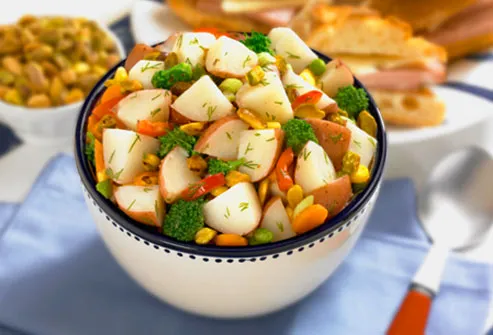 High-fiber veggies include artichoke hearts, green peas, spinach, corn,
broccoli, and potatoes. But all vegetables have some fiber -- from 1 to 2
grams per 1/2-cup serving. To boost your fiber intake, add vegetables
to omelets, sandwiches, pastas, pizza, and soup. Or try adding
interesting vegetables -- such as beets, jicama, Jerusalem artichokes,
or celeriac -- to a salad or other meals.
High-fiber veggies include artichoke hearts, green peas, spinach, corn,
broccoli, and potatoes. But all vegetables have some fiber -- from 1 to 2
grams per 1/2-cup serving. To boost your fiber intake, add vegetables
to omelets, sandwiches, pastas, pizza, and soup. Or try adding
interesting vegetables -- such as beets, jicama, Jerusalem artichokes,
or celeriac -- to a salad or other meals.
Fiber in Dried Fruit
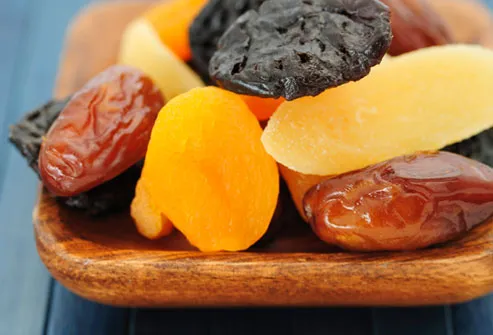 Prunes are well known for their ability to help digestion. That's in
part because of their fiber content -- about 3.8 grams in a 1/2 cup.
Most dried fruits are loaded with fiber, which can help regulate bowel
movements and relieve constipation. Try having a handful of dried figs,
dates, raisins, or apricots as a snack. Or chop them up and sprinkle on
top of cereal or whole-grain dishes.
Prunes are well known for their ability to help digestion. That's in
part because of their fiber content -- about 3.8 grams in a 1/2 cup.
Most dried fruits are loaded with fiber, which can help regulate bowel
movements and relieve constipation. Try having a handful of dried figs,
dates, raisins, or apricots as a snack. Or chop them up and sprinkle on
top of cereal or whole-grain dishes.
Fiber From Beans
 From adzuki to Great Northern, beans are high in fiber, packed with
protein, and low in fat. Try eating beans instead of meat twice a week
for a fiber boost. Use them in soups, stews, salads, casseroles, eggs,
and with rice and pasta dishes. Or boil edamame beans for four minutes
and sprinkle with salt for a healthy snack. Be sure to wash down all
that extra fiber with plenty of water to avoid constipation and gas.
From adzuki to Great Northern, beans are high in fiber, packed with
protein, and low in fat. Try eating beans instead of meat twice a week
for a fiber boost. Use them in soups, stews, salads, casseroles, eggs,
and with rice and pasta dishes. Or boil edamame beans for four minutes
and sprinkle with salt for a healthy snack. Be sure to wash down all
that extra fiber with plenty of water to avoid constipation and gas.
Fiber in Peas and Other Legumes
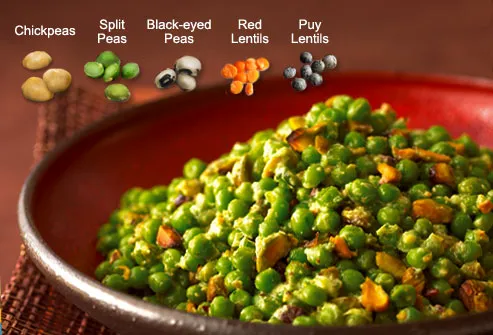 Lentils and peas are related to beans and share their dietary profile --
high in fiber and protein and low in fat. Lentils cook more quickly
than most other legumes and are a favorite in soups and stews. Cooked
chickpeas can be added whole to salads, or blended to make hummus. All
legumes are a healthy addition to your diet. But add them slowly to help
prevent bloating and gas.
Lentils and peas are related to beans and share their dietary profile --
high in fiber and protein and low in fat. Lentils cook more quickly
than most other legumes and are a favorite in soups and stews. Cooked
chickpeas can be added whole to salads, or blended to make hummus. All
legumes are a healthy addition to your diet. But add them slowly to help
prevent bloating and gas.
Nuts, Seeds, and Fiber
 Many people steer clear of nuts and seeds because they tend to be high
in calories and fat. However, they can be a great source of fiber and
other nutrients. A 1/4 cup of sunflower seed kernels, for example, has
3.9 grams of fiber. One ounce of almonds has 3.5 grams. Try adding
chopped nuts or seeds to salads or yogurt. Or enjoy a handful of roasted
nuts or seeds for a healthy afternoon snack.
Many people steer clear of nuts and seeds because they tend to be high
in calories and fat. However, they can be a great source of fiber and
other nutrients. A 1/4 cup of sunflower seed kernels, for example, has
3.9 grams of fiber. One ounce of almonds has 3.5 grams. Try adding
chopped nuts or seeds to salads or yogurt. Or enjoy a handful of roasted
nuts or seeds for a healthy afternoon snack.
Enjoy Whole Grains with Dinner
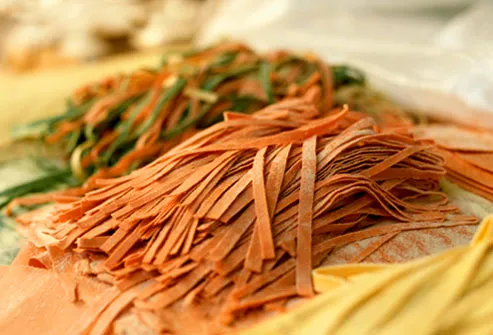 Enjoy brown rice instead of white with your meal. Or try whole-grain
noodles. For something different, make a dish with millet, quinoa, or
bulgur -- whole grains that are packed with fiber. Worried that grains
cause weight gain? Adding fiber to your diet can actually help prevent
weight gain by making you feel fuller longer. Fiber-rich foods also
require more chewing -- giving your body more time to feel full.
Enjoy brown rice instead of white with your meal. Or try whole-grain
noodles. For something different, make a dish with millet, quinoa, or
bulgur -- whole grains that are packed with fiber. Worried that grains
cause weight gain? Adding fiber to your diet can actually help prevent
weight gain by making you feel fuller longer. Fiber-rich foods also
require more chewing -- giving your body more time to feel full.
Add Flaxseed for Fiber
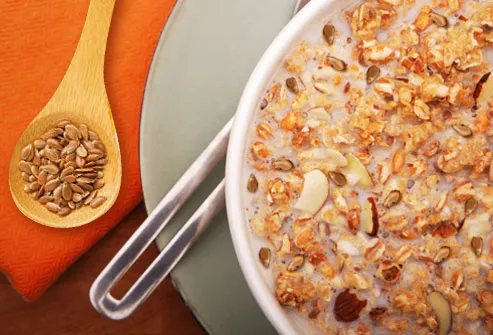 The seed of the flax plant can be an excellent source of fiber,
providing 2.8 grams per tablespoon of whole seeds. Flaxseed is often
used as a laxative. But studies have shown that it also may help reduce
cholesterol levels and decrease hot flashes. Add whole flaxseeds to
breads or other baked goods. Or sprinkle ground flaxseed into a smoothie
or onto cooked vegetables.
The seed of the flax plant can be an excellent source of fiber,
providing 2.8 grams per tablespoon of whole seeds. Flaxseed is often
used as a laxative. But studies have shown that it also may help reduce
cholesterol levels and decrease hot flashes. Add whole flaxseeds to
breads or other baked goods. Or sprinkle ground flaxseed into a smoothie
or onto cooked vegetables.
Buy Fiber-Enriched Foods
 If you can't work another serving of fruits, vegetables, beans, nuts, or
whole grains into your diet, consider eating a food enriched with
fiber. It's easy to find cereal, snack bars, toaster pastries, pasta,
and yogurt fortified with extra fiber.
If you can't work another serving of fruits, vegetables, beans, nuts, or
whole grains into your diet, consider eating a food enriched with
fiber. It's easy to find cereal, snack bars, toaster pastries, pasta,
and yogurt fortified with extra fiber.
Cheers,
Eve :-)











Comments